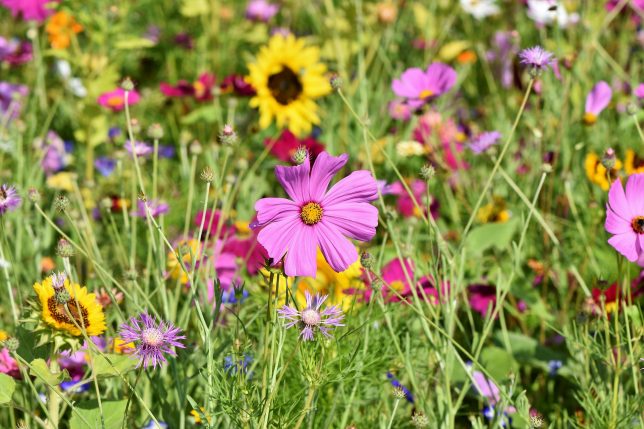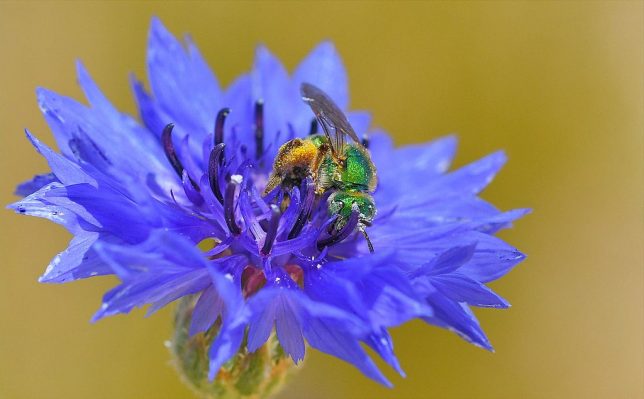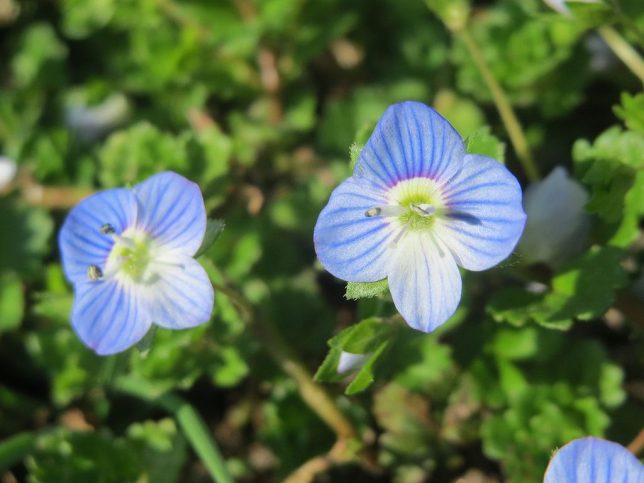
By Spoorthy Raman, Mongabay (CC BY-ND 4.0).
- A first-of-its-kind experimental study has found that climate change reduces the abundance of wildflowers and causes them to produce less nectar and fewer and lighter seeds.
- These changes also impact pollinating insects visiting the flowers: they have to visit more flowers, more frequently, to gather the required food.
- Fewer flowers imply reduced reproductive fitness in plants, as well as fewer food resources for invertebrates that rely on these plants for food, habitat and shelter.
- Overall, climate change may disturb the composition of wildflower species and their pollinators, impacting agricultural crop yields, researchers say.
Think of climate change, and you’ll probably picture devastating floods, raging wildfires, or parched earth. For the environmentally savvy, coral bleaching or masses of refugees may also make it to the list. Not many of us would think of the vibrant wildflowers in nearby meadows as victims of climate change. But the future of these pretty blooms could be gloomy in the face of a warming planet, suggests a recent study published in the journal Frontiers in Plant Science.
This first-of-its-kind study, conducted in the U.K., found that wildflowers across Northern Europe would likely see a steep decline in abundance — up to 40%. In the experimental study, the researchers simulated the warmer, wetter conditions predicted for the region due to climate change. Under this new scenario, some species of plants produced flowers with 60% less nectar and fewer or lighter seeds. Due to these changes, pollinating insects had to visit more flowers to gather the needed pollen and nectar, and visited each flower more frequently.
“Our results demonstrate that climate warming could have severe consequences for some species of wildflowers and their pollinators in agricultural systems, and shows that their community composition is likely to change in the future,” said lead author Ellen D. Moss, a research associate at Newcastle University in the U.K.
While theoretical studies have predicted that climate change could accelerate pollinator losses and wildflower declines, Moss’s study marks the first time scientists have put the theory to the test in an experimental setting. And previous climate change studies have focused on a small number of either plants or pollinating insects in a particular region, and not looked at the effects at a community level.
“This study adds to the weight of evidence that pollinators are at risk from multiple stressors,” said ecologist Jane Stout from Trinity College Dublin, who was not involved in the study. “They are losing places to feed and breed, and they are stressed by pesticides, disease and changes in climate.”
To do this, the researchers sowed spring wheat and a few native wildflowers, which grow on wheat farms, in small agricultural plots in a North Yorkshire farm. They then heated some of these plots with infrared heaters to increase the soil temperature by 1.5° Celsius (2.7° Fahrenheit) and they increased the water supply by 40% to mimic the predicted wetter conditions from future climate change for Northern Europe. The non-heated plots acted as a control in their experiments to compare their results with.
For two flowering seasons, 2014 and 2015, the researchers tracked the different plant species that grew in these plots, the number of flowers they produced, the volume of nectar in them, and the weight of the dried seeds resulting from the flowers. They also collected information about visiting insect pollinators, including their visiting patterns to both the experimental and untouched plots.
The study reported 25 plant species and 80 insect species in 2014, and 19 plant and 69 insect species in 2015. Higher temperatures and more precipitation didn’t change what species were found in the plots, with the most abundant wildflowers being corn marigold (Glebionis segetum), cornflower (Centaurea cyanus), common field-speedwell (Veronica persica), shepherd’s purse (Capsella bursa-pastoris), chickweed (Stellaria media) and red dead-nettle (Lamium purpureum).

Not only did wildlife abundance plunge by up to 40% in the heated plots, most of the plants in these plots also had fewer seeds in the seed heads, and the seeds weighed much less than those in non-heated plots. The only exception was the generalist weed known as common field-speedwell. While it produced more and heavier seeds in the heated plots, its flowers secreted 65% less nectar, making it a less popular flower with pollinators.
“A key finding [of the study] is that not all wild plant species respond to experimental manipulation in the same way, and so the implications for plant communities, and their interactions with pollinators, are complex to predict,” Stout said. Nevertheless, the general decrease in both the abundance and the number of seeds produced is of concern, she added, “because loss of floral resources in the landscape is already a major driver of pollinator decline.”
The study also found marked changes in the feeding behavior of pollinators in the heated plots. Hoverflies, honeybees and bumblebees, which were the most abundant insects, visited more flowers, and increased the frequency of their visits to the same flower to collect the nectar and pollen they needed.
“Fewer flowers and less nectar mean less food for pollinators,” Moss said, adding that such conditions may drive competition between pollinators and force them to choose less optimal flowers. “This could reduce their fitness and survival.”

A gloomy future for the blooms
Worldwide, two in five plants, including wildflowers, are threatened with extinction due to land use change for agriculture, housing and construction. In California, which is experiencing increasingly hotter and drier winters due to climate change, studies have recorded a decline of wildflower species by 15% in 15 years. In the U.K., human activities have destroyed about 97% of wildflower meadows since the 1930s, threatening once commonly seen plants like wild strawberry (Fragaria vesca), harebell (Campanula rotundifolia), and ragged robin (Silene flos-cuculi).
The loss of wildflowers also has a knock-on effect on thousands of insect species, including pollinators like bees and herbivores like aphids, grasshoppers and caterpillars. It also hits populations of natural pest controllers like spiders, ladybirds and lacewings that take shelter in the meadows. Studies show that, worldwide, a quarter of known bee species have not been seen since the 1990s, and loss of habitat is one of the primary reasons for the decline.
“[Climate change] risks crop pollination and our own food supply, but perhaps of more concern is the risk to wild plant pollination and our ecosystems and all the other benefits we get from them,” Stout said.
Tackling climate change by rapidly decreasing emissions would save at least some of the blooms, but in the meantime, there are other steps that could prevent a catastrophic future for wildflowers.
“The main things that will improve ecosystem resilience in the context of wildflowers and pollinators is to improve habitat quantity, quality and connectivity,” Moss said. “We need to leave more wild spaces for native plants and insects and try to connect these areas up so that these patches of high-quality habitat are not too small or too far apart.”
Citations:
Moss, E. D., & Evans, D. M. (2022). Experimental climate warming reduces floral resources and alters insect visitation and wildflower seed set in a cereal agro-ecosystem. Frontiers in Plant Science. doi:10.3389/fpls.2022.826205
(2020). State of the World’s Plants and Fungi 2020. Royal Botanic Gardens, Kew. doi:10.34885/172
Harrison, S. P., Gornish, E. S., & Copeland, S. (2015). Climate-driven diversity loss in a grassland community. Proceedings of the National Academy of Sciences, 112(28), 8672-8677. doi:10.1073/pnas.1502074112
Zattara, E. E., & Aizen, M. A. (2021). Worldwide occurrence records suggest a global decline in bee species richness. One Earth, 4(1), 114-123. doi:10.1016/j.oneear.2020.12.005
